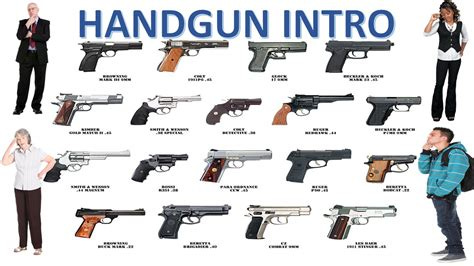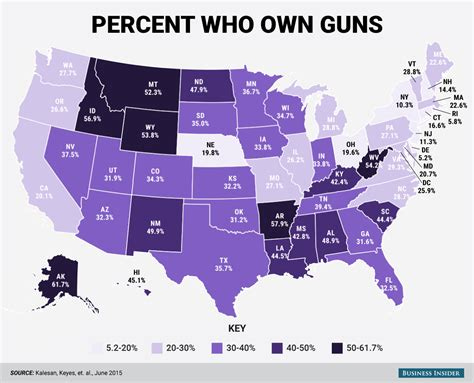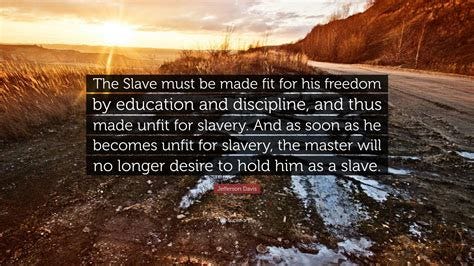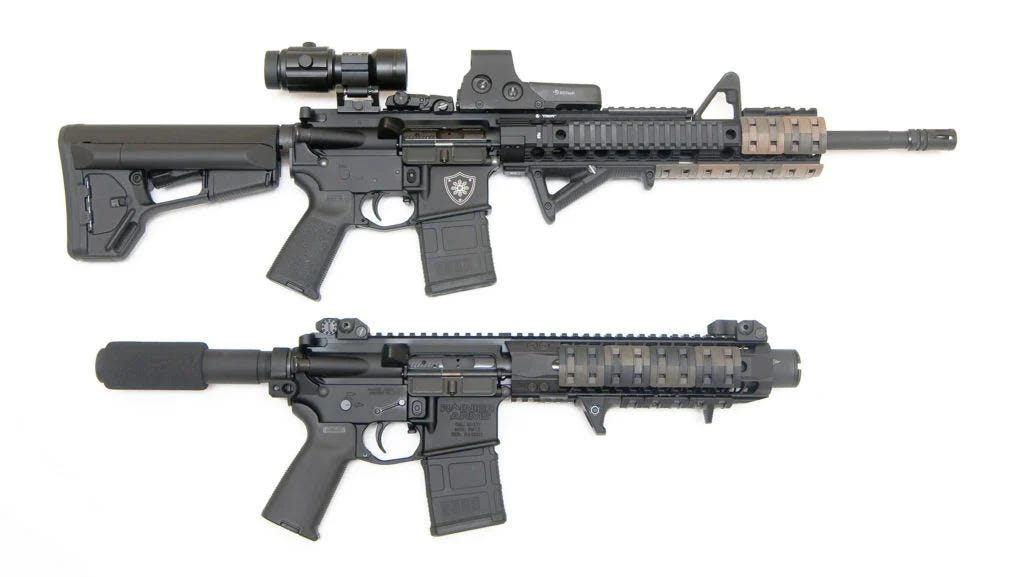What about 2nd-Amendment Options?
Think before you decide, and test after that.
Disclaimer: I am not affiliated with any of the manufacturers whose products I mention in the article, but I have personal experience and read a lot of comments and reviews backing them up.
My first article on the subject were mostly focusing on home defense and the potentials of defending against a foreign force:
This time, I would like to add a few obvious notes to what kind of handgun would make a good choice for most people. This type of information can make a difference, considering the amount of new gun owners since 2020, which amounts to 22.3 million people:
https://www.nssf.org/articles/since-2020-election-new-gun-owners-equal-population-of-florida/
It’s time for everyone to learn about details that have not been popular knowledge, but it must be by now. You are fighting a merciless enemy, and you must know your choices.
Here are the rules of choosing your handheld weapon:
Nonlethal is good as long as you are in a state that allows it, but only in situations where you can use your pepper spray effectively. Tasers CAN be lethal, so you must give them a second thought.
Reliability comes first. Modern handguns tend to be extremely reliable, but you can always get a lemon, so follow the instructions in #4. A Glock is supposed to be reliable, but that doesn’t necessarily apply to .22s.
Your ability to shoot straight with your choice of weapon beats the rest. That sort of thing can depend on the recoil (the ammo you are using), the barrel length and the weight of the frame material (even 357 Magnums are a lot tamer with a heavy body and a longer barrel). As strange as it might sound the cheapest stuff might work most of the time. Even an American-made Hi-Point (which doesn’t ever seem to fail, but it’s illegal in some states b/o its alloy used in the slide) can do the trick.
Ammo selection also applies to the target. I don’t carry my 357 Magnum, unless I go to places where it might be needed.
Taking your new gun to the range and making sure you find the ammo that works best with them is an absolute must, if you want to wager your life on it in the future. Many guns need a “run-in” time, which can mean 200-500 shots, after which you must shoot another 1,000 shots without a single failure. Guns with second-strike capability are more forgiving, and revolvers can just try the next piece of ammo, if one fails.
Shooting dirty ammo (all rimfires are dirty, and .22s are the most common among them) means that your gun needs much more frequent cleaning. You will also find that some ammo shoots cleaner than others even in center-fire guns.
Select a gun with a caliber you can handle. 357 Magnums were standard police issue in the 1970s and 1980s, but their low magazine capacity and their extremely violent recoil, and snubnose revolvers that shoot 357s (here is a cheap one) can also shoot 38 Specials, which are just about as forgiving as a 9mm. Still, 357s can also shoot bears and attack pitbulls, so using them can be a choice for a particular environment.
Revolvers don’t fail, unless extremely abused or are lemons, but you can shoot them from your pocket, which doesn’t exactly fly with semi-autos. Still, I would prefer not to fire a 357 Magnum from my pocket; it can cause burns, and I cannot guarantee that less powerful ammo would not (never tried to do that). Bags and purses, however, might work. At the same time, I would caution ladies to carry in a purse, because that’s what an attacker would grab first.
The weight of the gun must match the power of the ammo in order to decrease recoil to keep it manageable for the user. Most people can handle 9mm, but not much beyond that. A 10mm can pose similar challenges to a 357 Magnum, but if you have to shoot bears or attack pitbulls, it’s still probably your best choice (just make sure you keep practicing so that it wouldn’t jump out of your hand).
Backup weapons can also be useful. Just about anyone can fire a 380, and there are extremely small or reliable options. The Ruger 380 Max, for one, has a high capacity mag for a tiny package. Many swear on the S&W 380 Bodyguard, which also had similar problems to the Ruger. Once you test yours, as I explained it in entry #4, you are all set. For reliability, I favor the Bersa 380.
When carrying two weapons, reliability and manageability are the two main concerns. Strange as it is, I prefer to carry the Ruger Max in a holster (anything larger is uncomfortable, while driving), and an old-timer Bersa 380 in my pocket, with two extra mags for each. The Bersa has a 15-mag capacity version, but it doesn’t have the several-decade-long history of absolute reliability (it is actually used by law enforcement in some places), the newer version is thicker, which hampers concealability, and in that case, I might as well carry my Glock 19.3 (seriously upgraded), a Taurus G2C, or something else in my stock.
An extra gun tends to work better than a single one, because there is no problem with reloading. Also, different calibers can give you a choice for self-defense under specific circumstances, like I would prefer my 357 Magnum in a pitbull attack over a dozen 9mms, 38 Specials, or 380s, and would certainly carry it in the wild for other wild animal threats).
Criminals wearing body armor are difficult targets. Shoot where there is no armor (head shots are only for pros, and this article is primitive for them), and take your follow-up shots with some consideration. A 12GA slug or even a 357 Magnum would break a few ribs even through standard body armor (you might have to shoot several times for the armor would give in), rendering the attacker incapacitated for a few seconds, which you must use for disarming and, possibly, getting rid of your attacker, if there are more. For high-grade body armor, you would need green-point 5.56 ammo shooting at the same spot a number of times, but a 7.62 or a 308/300 supersonic can do the job faster… I just hope, you’ll never need that knowledge and skill…
When it comes to two carry guns, you might want to consider practicing with your weaker hands in case your stronger one gets injured or you need two-handed shooting.
Manufacturer’s warranty can be another problem. Some only cover first-time buyers, while others all the time.
Ultimately, don’t harm your hearing, if you can manage. Shooting in a confined area, especially if it’s a small one, you are most likely going to damage your hearing or even go deaf. The pain you’ll feel is something you may not be able to imagine, either. As miserable as it sounds, even something as stupid as covering an ear with the free upper arm and use a finger on it for the other ear might help. Suppressors can work well on .22s, but if you read my previous articles on the subject, you will find that not all suppressors are created alike.
One more thing about what movies don’t get right besides the fact that a handgun fired through a suppressor can still deprive you of your hearing in confined places (like a car or a small room/closet) is that shooters in movies shoot once and wait for the result. In a self-defense situation, you must shoot as many times as needed to stop the attack without wondering if it has. Saving ammo for potential attackers can also be a concern.
Another reason to shoot only as long as you must is that you must NOT shoot an attacker once (s)he is fully incapacitated; that can land you in court and charged with homicide.
Altering the trigger to get a lighter or shorter pull/recovery can also result in indictment for accused of being “careless” and shooting “by accident.”
Okay, I forgot about the most important part. Shot placement is what mostly matters, especially if you are using a .22. Also, a soft-point from a .22, when the barrel faces the skull, blows up the brain, and it leaves no identifiable mark as long as the casing is saved, which is actually a major advantage of using a revolver. Leaving no casings behind is also a feature of this option… I am not advising you to use it, but remember, it can be used against you…
Whatever you choose, you might agree with me that you are NOT government property, and will never be a slave:
The following is the last one in this sequel:
More about Using Your 2nd-Amendment Rights
This much, and more, should be clear even after my first article.






The biggest problem with self-defense using firearms is that the instant you pull that trigger and let off a round, the police will get involved. They will confiscate your firearm and possibly others you might own. They will pursue the investigation as if you are the criminal, even in clear cases of self-defense. Best case scenario, you will at least lose that tool for the duration of the investigation and it might get returned. But you will be under full scrutiny of the local authorities who will likely prosecute you before the offending party.
I suspect they likely have a frequency that can detonate ammunition while still in the mag. That, to my thinking, must be how they're planning on handling the guns en masse when/if the situation goes completely testicular.
Gunpowder isn't a primarily polar molecule, but there are apparently (according to GPT) polar molecules in the mix. M-waves react to polar molecules. Just gotta heat up those few polar molecules past a certain level and I assume the whole round goes, like an interior primer. Granted I'm no scientist, but from what I've learned (it's all energy vibrating)... That's what my instincts are telling me.
It's a theory, anyway. That's all I've got at this point. Curious about everyone's takes on it. ❤️